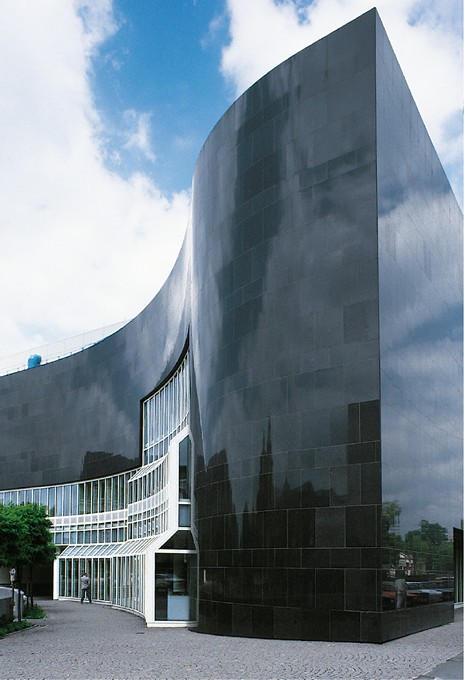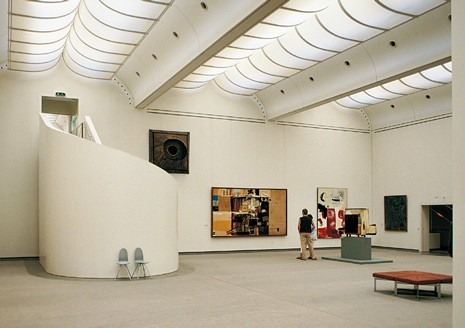Description
This collection of modern painting, extant since 1960 and one of the most exquisite of its kind, acquired a fitting domicile in this new building. The building by the Danes Hans Dissing and Otto Weitling, who were students of Arne Jacobsen, is characterized by solid nobility and a high degree of functionality. The extended layout and elegant, laterally curving façade of weatherproof black granite from Bornholm, polished mirror-smooth, not only gives the rather heterogeneous Grabbeplatz – whose disparate buildings cast multi-faceted reflections on it – a properly urban setting, but also intimates the treasures hidden within its hermetic secrecy. The interior, fully air-conditioned in the collection area, is accessed by a rather too casual entrance area and a narrow, but cleverly laid out and very detailed, carefully worked out cream-coloured staircase with two glass lift shafts and three stairways staggered in parallel. The collection rooms of varying sizes, organized by an orthogonal structure, are interlinked by openings arranged in enfilade but without any kind of framing to emphasize them. Sometimes they offer only one way of circulating, sometimes two. These rooms are lighted by daylight from above, with the exception of several rooms in the annexe for the collection of small pictures by Paul Klee. This very significant requirement induced the architects to plan the building from top to bottom so to speak, and to extend the exhibition rooms of varying heights to the roof. Thus the circular tour of the museum (which does not in fact prescribe a necessary sequence of rooms) descends from the smaller gallery rooms on the third floor via a sculptural stairway to the larger room for post-war art two storeys high, down to the enormous 12-metre-high room for temporary exhibitions. The rooms are lit by transparent reflecting screens of matt acrylic glass which, as bands of skylights all running in the same direction together with their concave longitudinal beams, form an elegant double curve coming to a pointed end in the ridge line. These bands of light – a refined structure first tried out in principle by Louis Kahn in the Kimbell Art Museum – also form the module whose multiplication results in the different dimensions of the museum rooms. Even though they are somewhat overemphasized from a decorative perspective, these bands of light nonetheless generate an almost ideal illumination; the fact that the skylights are sheltered by shade constructions means that they let in not only northern light, but also a little southern light.
wettbewerbe aktuell 2/1976, pp. 83-100 • Bauwelt 19-20/1976, pp. 582-586 (competition) and 17/1986, pp. 620-626 (Peter Rumpf) • Ingeborg Flagge, Kunstsammlung NRW (Architektur in der Demokratie 2), Düsseldorf, 1986 • Manfred Sack/Dieter Leistner, Kunstsammlung Nordrhein-Westfalen Düsseldorf, Stuttgart, 1986 • Hannelore Schubert, Moderner Museumsbau, Stuttgart, 1986, pp. 169-171 • Techniques et Architecture 386/1986, pp. 78-83 • Architecture and Urbanism 2/1987, pp. 19-40 • Baumeister 1/ 1987, pp. 44-51 • Deutsche Bauzeitung 1/1987, pp. 22-27 (Ingeborg Flagge) • Jost Schilgen, Neue Häuser für die Kunst, Dortmund, 1990, pp. 106-121 • Josep Maria Montaner, New Museums, New York, 1990, pp. 58-63
Drawings
Second floor
Third floor
Cross section
Detail of the lighting technology construction
Photos

View of the sculptural, curving form of the main façade

View of a triple-axis exhibition room on the first floor
Originally published in: Paul von Naredi-Rainer, Museum Buildings: A Design Manual, Birkhäuser, 2004.